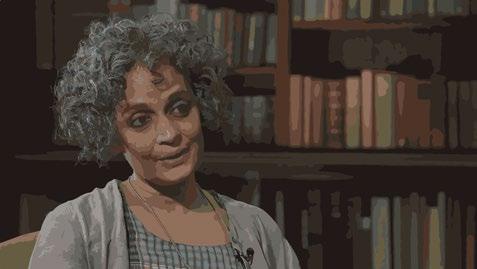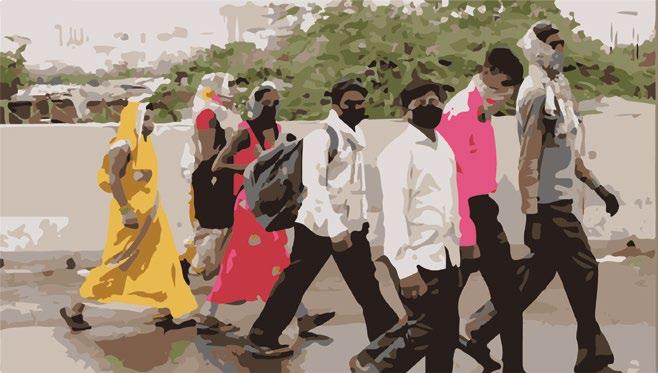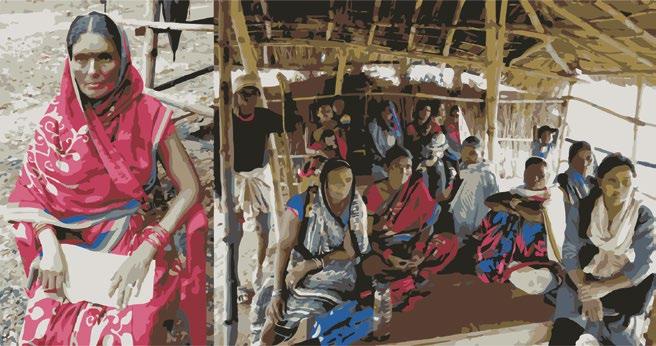
9 minute read
Muslims
Shahida, Delhi Riot Survivor Image: Amnesty
Muslims: A persecuted religious minority in India
Muslims are the largest minority in India and arguably the most persecuted one. As per the 2011 Census data there are 172.2 million Muslims in India which comes to 14.2% of the total population. The British fomented a communal divide to quell the burgeoning revolts to their oppressive rule. This led to the Partition where Pakistan opted for religion-based nationhood, while India remained secular. While a vast majority of Muslims opted for staying behind, putting their faith in the Indian Constitutional values of equality and non-discrimination, the reality of Pakistan has been continually used as an intimidation and threat against them. Organizations who themselves had little or nothing to do with the Indian freedom struggle and who have, instead openly propagated religion-based nationhood for India, have held second class citizenship as a constant threat to the religious minorities and the political dissenter.2
The assassination of Mahatma Gandhi on January 30, 1948, was an act carried out by proponents of this very ideology, as they found his commitment to Hindu- Muslim unity and composite nationhood a threat. The Rashtriya Swayamsevak Sangh (RSS) was banned by the Indian government after its functionaries were found to be directly or indirectly involved in the act and its celebration.
The poor share that Muslims have got in the socioeconomic share of India’s development has been documented by the government.3 Detailed analyses show that in areas like public sector and government employment, Muslim participation has been affected by the existence of institutionalized discrimination, whereas in those like the arts, cinema and sports
–where prejudice does not so easily manifest—Muslim presence not just flowers but excels.4 This discrimination has worsened with the ascendance to power of the hardline parties to power. A culture of impunity pervades with powerful perpetrators escaping the long arm of the law, especially when it comes to attacks against the minorities and India’s marginalized sections. The targeting of Muslims in India has taken different forms over the decades.5
After these bouts of targeted pogroms, came the full blown genocidal carnages like Gujarat 20026 and Muzaffarnagar 2013. Since 2014, the forms of violence have shifted to individual, horrific and targeted cases of spectatorial lynchings. Though in February 2020, we saw a return to a full-blown carnage in Delhi. The violence was a clear retaliation to the successful peaceful and democratic protests against the amendments to the Citizenship Law (CAA 2019) that brought in discriminations based on religion. In 2013, the northern state of Uttar Pradesh saw another bout of violence that began with an intra-community conflict and then took the shape and form of targeting the religious minorities. Ever since a hardline BJP came to power in the Centre in 2014, Muslims in India have increasingly become targets of mob lynching in the name of cow protection, criminalization of triple talaq, and targeted and inciteful hate speech. Cases of Mohsin Sheikh (Pune), Mohammed Akhlaq (Dadri), Pehlu Khan (Alwar) and Alimuddin Ansari (Jharkhand) are still fresh in public memory. Muslims are also reeling under the evil of the caste system. The upper castes among Muslims are Ashraf Muslims, equivalent to Brahmins in Hindus who hegemonize Islamic organizations and institutions, including educational institutions. The backward, Dalit and tribal Muslim communities — Raeen, Ansari, Mansuri, Qureishi, Alvi, Salmani, Halalkhor, Ghosi, Hawari, Saifi, Siddiqui, Idrisi, Van Gujjar, etc. have organized themselves under the identity of Pasmanda (Persian for those who have been left behind)7 The victims in nearly all communal incidents are almost always the subordinate castes while the beneficiaries are the forward caste sections.8 In the fourteen Lok Sabha elections until 2019, only 60 Muslims from Pasmanda background have been elected.9
Religion, citizenship and law
The ruling government’s anti-Muslim agenda materialized when it passed the discriminatory CAA which enables non-Muslim communities from Pakistan, Bangladesh and Afghanistan to get citizenship in India. This was to be followed by preparing a National Register of Citizens (NRC) to identify citizens in accordance with the citizenship law. This was to be preceded by the National Population register (NPR), this whole process was to gather documents from people so that they could prove their citizenship and the ones who wouldn’t be able to prove the same would be granted easy citizenship under CAA and the only ones who would be left out would the marginalized Muslim community members. This led to countrywide protests.
Justice for minorities
When it comes to our courts, Muslims have often faced situations where justice was allegedly delayed. While the land dispute in the Ayodhya case was resolved by the Supreme Court by handing over the land where Babri Masjid once stood to the Hindu plaintiffs, the criminal trial of the demolition of the mosque is still on going at the special CBI court. Judgement is now due on September 30, 2020. The Supreme Court, has time and again extended the deadline set for conclusion of the trial in which many BJP leaders are accused.
Punishment of perpetrators of the Gujarat 2002 genocide broke the pattern of impunity because of the rigorous intervention of citizens legal rights groups. As many as 172 persons were convicted, 124 to life imprisonment due to the active intervention of Citizens for Justice and Peace. The coming to power of those in close alliance with the perpetrators, however has begun to negatively influence even this.10
In the Pehlu Khan case, there was an alleged attack on the lives of Khan’s sons and lawyer. While lower courts convicted the perpetrators in the Alimuddin Ansari case, the accused got bail from higher courts and were even garlanded by former Union Minister and BJP leader Jayant Sinha at a felicitation ceremony.
Current scenario
The February 2020 violence of North East Delhi which took place in the backdrop of protests against the controversial Citizenship Amendment Act (CAA) led to over 70 Muslim deaths. This pogrom appears to have been an attempt to intimidate the Muslim community. Many fact-finding reports have highlighted instances of police inaction and even complicity in the targeting of Muslims, not much unlike the Gujarat genocide of 2002. Mobs, allegedly owing allegiance to hardline parties, were seen stopping men in the streets demanding to see their ID cards. If anyone refused, they were forced to show whether or not they were circumcised, as is common among Muslim men.11 One instance of religion driven hate crime that caught the attention of even international media was of Tabrez
“Over the last couple of years, we have had so many instances of mob lynchings and George Floydtype killings – the difference in India being that Hindu(tva) vigilante mobs do the killing and the police, the legal system and the political climate help them to1 get away with it” – Arundhati Roy

Ansari (24) who was beaten for hours until he died at the hands of a Hindu mob forcing him to chant praises of Lord Ram. His family says they were threatened by the police with a similar fate when they begged to get him treated while he was in custody.12 Eleven people have been charged in the case for murder.
The way forward
Expedite hearings in cases of communal riots against minorities to bring them justice Enact the Prevention of Communal & Targeted Violence (Access to Justice & Reparations) Bill, 2011.13 Strengthen the National Commission for Minorities and mandate its members to be part of investigation teams that inquire into incidents of communal violence Make lynching and other communally motivated crimes punishable under the Indian Penal Code Formulate an Equal Opportunity law to protect minorities from discrimination in social and political spheres
1) https://www.opendemocracy.net/en/arundhati-roy-indian-muslims-facing-genocidalclimate-amid-pandemic/ 2) https://sabrangindia.in/indepth/ideology-rashtriya-swayamsevak-sangh-rss-both-hateridden-and-supremacist-part-1 3) The findings of the Justice Rajinder Sachar Committee report Social, Economic and Educational Status of the Muslim Community of India, submitted in November 2006 to the prime minister, had some significant findinfs, A similar if not as exhaustive initiative commissioned by former PM Indira Gandhi in the early 1980s, remained a document on paper. A summary can be read here https://www.sabrang.com/cc/archive/2007/jan07/index.html 4) https://www.sabrang.com/cc/archive/2004/july04/report1.html 5) In the 1980s and 1990s –as the economic situation of Muslims improved after being devastated in the decades following Partition and Independence—targeted pogroms were frequent with the northern states of Uttar Pradesh (UP) and Bihar seeing many (Nellie, Assam (1983), Meerut-Hashimpura, UP (1987), Bhagalpur, Bihar (1989), Bombay (1992-1993) are only a few of the examples. See: https://www.sabrang.com/srikrish/hinrole.htm , Through the late 1980s-1990s, the campaign for a Ram Temple at Ayodhya was nothing but a euphemism for an attack on the Indian Constitutional Order and bloodletting against India’s largest minority, the Muslims., Gujarat with a vicious history of anti-minority violence saw a bout in 1969. In many or all of these judicial commissions of inquiry constituted by governments at the time, identified targeted hate speech and writing as instrumental in building an atmosphere conducive to the outbreak of targeted crimes and pinned the blame on institutionalised bias in the law and order machinery (police). Perpetrators were however not ever punished in criminal prosecutions by the state deepening the culture of impunity. See: https://www.sabrang.com/srikrish/antimin.htm That decade saw hate getting legitimacy and the increasing marginalization of Indian Muslims. This anti- Muslim rhetoric culminated in the demolition of the Babri masjid in 1992, an act that was preceded and followed by brute attack on Muslim life and property. In all these bouts of violence hardliner organizations, owing allegiance to the ideology of Hindutva (a politically instrumentalised Hindusim)—these organizations are allied to the ruling Bharatiya Janata Party (BJP). See: Khakhi Shorts & Saffron Fl ags, Orient Longman; https://www.goodreads.com/book/show/1490272.Khaki_Shorts_and_Saffron_Flags; https://www.sabrang.com/tribunal/vol2/prepvio.html 6) The 2002 Gujarat carnage was a reaction to the burning alive of 58 persons on a train travelling from Faizabad (UP) to Godhra (Gujarat). Many of those who died are believed to have been kar sevaks (Religious volunteers). What followed was 300 incidents spread over days and weeks in 19 of the state’s 25 districts where state functionaries and elected representatives failed in their duty to protect lives. As many as 2,000 innocent Muslim lives were lost in this targeted retaliatory violence, property worth millions belonging to the minority were destroyed and places of religious and cultural worship were desecrated. Gendered violence took a new, widespread and organized form, hate speech and accumulation of arms had preceded the Godhra train burning. The Concerned Citizens Tribunal- Crimes Against Humanity report on Gujarat 2002 held the then chief minister, Narendra Modi to be the ‘chief architect of the state sponsored genocide.’ For several years, the United States refused a visa for his travel to the country, that was till he became prime minister. 7) https://theprint.in/opinion/indias-muslim-community-under-a-churn-85-backwardpasmandas-up-against-15ashrafs/234599/ 8) https://theprint.in/opinion/indias-muslim-community-under-a-churn-85-backwardpasmandas-up-against-15ashrafs/234599/ 9) https://www.milligazette.com/Archives/2004/16-30Nov04-Print-Edition/163011200463.htm 10) In January 2020, the Supreme Court granted interim bail to 14 convicts involved in killing of 23 Muslims in Sardarpura village. In 2011, 33 had been convicted to life imprisonment. In the Naroda Patiya case where about 97 people died, elected representative from the BJP and a minister in the Gujarat cabinet, Maya Kodnani, Bajrang Dal leader Babu Bajrangi, were the prominent accused. A special court had convicted both in August 2012; but the Gujarat High Court acquitted Kodnani in 2018 and Bajrangi has been granted bail on medical ground in 2019 by the Supreme Court. 11) https://www.theguardian.com/world/2020/mar/01/india-delhi-after-hindu-mob-riotreligious-hatred-nationalists 12) https://time.com/5617161/india-religious-hate-crimes-modi/ 13) https://www.sabrang.com/cc/archive/2011/nov11/index.html










